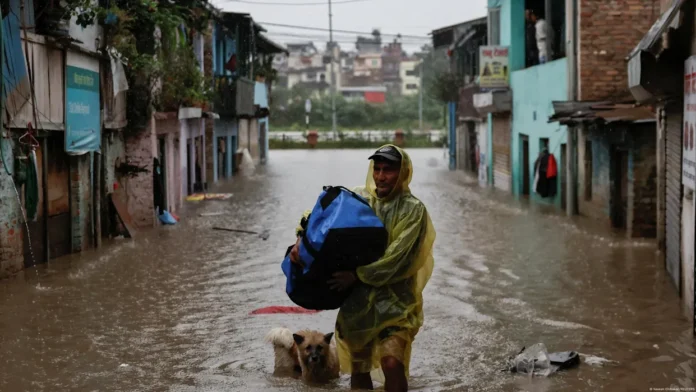Landslides and floods triggered by days of heavy rain have killed at least 64 people across Nepal and India, officials said Sunday, as rescue teams struggled to reach remote communities cut off by blocked roads and rising rivers.
Nepal has been battered by torrential downpours since Friday, leaving rivers swollen and several areas inundated. According to Shanti Mahat, spokesperson for Nepal’s National Disaster Risk Reduction and Management Authority, 44 people have died and five remain missing.
The eastern district of Illam has been hit the hardest, with at least 37 people killed by landslides overnight.
“Heavy rains overnight caused the landslides. Rescue workers have reached the affected areas. It was difficult because many roads were blocked.” said local district official Sunita Nepal.
In the capital, Kathmandu, rivers have overflowed, flooding settlements along their banks. Security forces have been deployed with helicopters and motorboats to assist in rescue operations.
“There is some damage, but thanks to the authorities’ prior flood alert, we were able to move some belongings to a safe place,” said Rajan Khadga, a 38-year-old vegetable seller.
The downpours have blocked major highways and disrupted flights, leaving hundreds of travelers stranded, many of them returning home after celebrating the Dashain festival.
Prime Minister Sushila Karki said emergency services were “fully prepared for rescue and relief” and urged people to seek help if needed.
“Your safety is our utmost concern. Do not hesitate to seek necessary assistance,” she said. The government declared Sunday and Monday public holidays and advised citizens to avoid unnecessary travel.
Across the border in India’s West Bengal state, at least 20 people were killed after flash floods and landslides swept through Darjeeling district. Heavy overnight rain destroyed homes and infrastructure in the hill region.
“In the wake of last night’s heavy cyclone in the Darjeeling hills, over 20 people have lost their lives,” said Harsh Vardhan Shringla, a lawmaker in India’s upper house.
Television footage showed rescue teams using cables to reach isolated areas as torrents of water smashed bridges and collapsed roads.
Prime Minister Narendra Modi expressed his condolences, saying he was “pained by the loss of lives” and that authorities were closely monitoring the situation.
India’s weather agency issued a red alert for “extremely heavy rainfall” in sub-Himalayan areas, including Darjeeling, through Monday.
The heavy rain has also affected neighboring Bhutan, where swelling rivers prompted joint rescue operations with the Indian army. Military helicopters were deployed to evacuate civilians stranded in the border town of Phuentsholing.
South Asia’s monsoon season, which typically lasts from June to September, brings annual floods and landslides that claim hundreds of lives. Experts warn that climate change is making these disasters more intense and unpredictable.
The International Centre for Integrated Mountain Development, based in Kathmandu, cautioned earlier this year that communities face increasing risks during this monsoon season. “Rising temperatures and more extreme rain raise the risk of water-induced disasters such as floods, landslides, and debris flows,” the group said.

